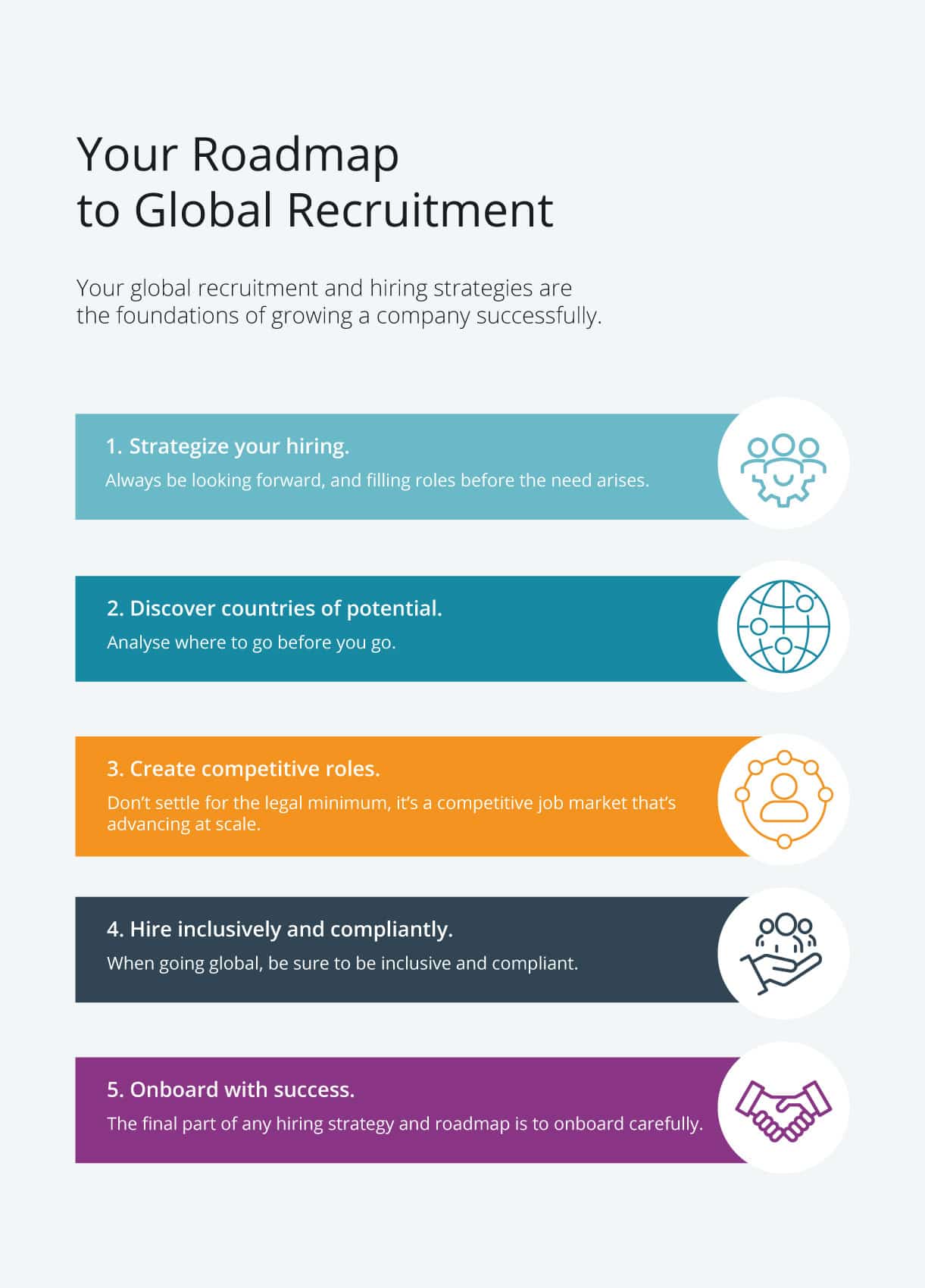Global Recruitment Strategies: How to Hire Effectively
The new normal, the great reshuffle and the hybrid workplace have all been used to describe the current state of employment we’re seeing. It’s a changing world, and one that companies need to adapt to, or face losing out on top talent. This is incredibly prevalent in global hiring, where the need to attract the best talent from each country you expand into means going above and beyond.
As LinkedIn’s 2022 Global Talent Trends report puts it, this is a ‘once in a generation’ moment for both disruption and opportunity. It’s a once in a generation disruption, caused by a global pandemic shifting people’s priorities. And it’s a once in a generation opportunity to be cemented as a leader in culture and recruitment strategies.
Creating a Global Recruitment Strategy
When preparing to hire globally, especially from the US to other countries, it’s imperative that you are aware of not only the legal requirements of hiring in your chosen country, but that you can offer a competitive role.
As well as making sure you remain competitive abroad, you also need to understand the local differences, culture, law, regulations and colloquialisms. While you may think you have a grasp on the specifics of each country, having an in-country partner to manage your international HR on a local scale is a great way to overcome these complications.
Your Global Recruitment Roadmap

1. Strategize your Hiring
Always be looking forward, and filling roles before the need arises.
Hiring isn’t a load and fire type of task. It needs to be planned, coordinated and fully aligned with a business’s goals, as well as reflective of the working culture and expertise in respective countries.
When approaching global recruitment in a new country, you need to be sure that you have correctly identified:
- The location you are hiring in
- The salary, bonuses and other compensation
- The role you are hiring for
- The type of employment opportunity (hybrid, part time, contract worker etc)
Hiring strategies will be unique to each company, but you should always look to hire both for your current situation, but also with a forward-thinking strategy. For example, if you need to hire to cover a role in a department that is being phased out, then look at how you can adapt that role going forward.
When going global with your hiring, also be sure to create in-country strategies with global strategies. These will ensure that every division of your company can be flexible with in-country hires while contributing to the overall goals of the company.

2. Discover countries of Potential
Analyse where to go before you go.
If you have yet to expand globally, it’s important that you don’t hire at will. You need to consider where your talent pool is, the working culture and also any further expansion opportunities.
For example, placing your division in a country such as Malaysia, whose main expertise lies in healthcare, tourism and manufacturing, may not provide you with the hiring pool you want for a growing professional services company.
Instead, Indonesia, which is fast becoming a STEM-dominant country, will have the resource groups you want, and the education levels and interest to allow you to rapidly expand with competitive job roles.
Before you begin to expand, carefully select where you want to expand to. Or you end up having to relocate your entire in-country division as the resource and expertise you are looking for isn’t readily available in your chosen country.

3. Create competitive roles
Don’t settle for the legal minimum, it’s a competitive job market that’s advancing at scale.
Competitive roles are what every company strives to achieve. However, when first hiring in a new territory, you need to not only remain competitive within your existing benefit structure, but also above what is considered good in your chosen area of expansion.
As a new hiring entity, it’s important that your first hire has a competitive salary, benefits and other compensation that is above not only the legal requirements, but the expected compensation levels in that country. While a country may have a legal requirement for compensation, there may be unspoken expectations that only a local expert would know. For example, in America there is a discrepancy between states on minimum wages, and a low federal minimum wage, yet employees will expect far above that for many jobs.

4. Hire Inclusively and Compliantly
When going global, be sure to be inclusive and compliant.
Going global requires a different approach to diversity. Where in the US you may have one set of requirements, you need to adapt these when going global, as the US has comparatively lax requirements on diverse hiring and reporting. Compliance also needs to be a point of development, as other countries will have strict compliance requirements you may not be aware of.
For example, companies within the EU will need to comply with GDPR (General Data Protection Regulation). Outside of America, there is very rarely a difference in law and compliance regulations across one country. Instead, the rules in one area will apply countrywide. This means that you’ll need to be clear on the compliance laws for the entire country, rather than the specific area you may be hiring in.
Another consideration is the cultural differences. From national holidays, leave and lunch culture, as well as the onboarding and hiring processes, it’s key that you are not only aware of what the expectation is but are able to listen and learn from new employees who can provide insight into what their country is like.
It is rare to get it right first time, but the companies that are able to listen, learn and adapt will be the ones who see true success.

5. Onboard with Success
The final part of any hiring strategy and roadmap is to onboard carefully.
Once you have found a candidate, gone through the required hiring processes in your chosen country, it’s time to onboard. Onboarding should always be part of your hiring strategy as it’s the final, and most important, part of employee acquisition. It’s the gap between acquisition and retention.
With onboarding in a global hiring process, you should enable them to feel part of the global company, as well their in-country office. It’s important that each employee knows and understands what the overall goal of the business is, as well as what their country’s role is. For example, are they helping to expand into new markets, improve an area of the business that their country has as a primary export, or an alternative function?
Onboarding should cover all of these points, get them to meet their teams, learn about the company, and more.
Infographic: Global Recruitment Roadmap


Are You Looking to Hire Overseas?
Speak to the experts here at IRIS FMP. We’ve expanded companies across 135 countries and can help you do the same.